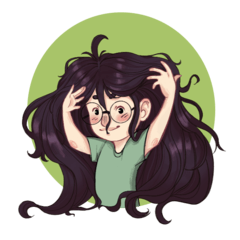Painting backgrounds for webcomics.
Hello everyone! This is Inma R.
I'm currently working on a webcomic and I'm going to share my technique to work on the backgrounds for it. This tutorial is for people who
1) Can't really draw backgrounds.
2) Don't have the time to draw ellaborate backgrounds or paint them, but who really want to tell their stories.
You can either watch the video or read the article below~
Video.
Written steps.
NOTE We need Clip Studio Paint EX for this tutorial, since some functions are not available on the Pro version.
1) We start by dragging and dropping any 3D background from our Material folder into the panel.
2) After we place the object in the position we want, we right-click on the 3D object layer and click on LT Conversion of Layer. This window will pop up.
3) Make sure the Extract Line option is set to "Raster layer".
4) Check "Preview" to see what the shadows look like on the actual image.
5) I like to have two levels of shadows (how dark they are doesn't matter, this is just for preview purposes). I make the lighter one cover most of the background and the darker one cover only parts of it.
6) We click ok to perform the conversion.
7) We hide the layers with the screentones (this is a full color webcomic, we don't really need screentones.
8) We right-click on the lineart layer and click on the "Convert layer" function to turn the layer into a color vector layer.
*I could have made the conversion directly to a vector layer on the LT conversion step, but I choose to convert it later because I get better lineart results.
9) Using the object tool on the Operation menu, I change the brush shape to one of my pre-registered pencil-like shapes.
*You can pre-register many different brush shapes. If you want to learn how, I explain about it on this other video: https://youtu.be/AcPh7Cb_dyo
10) We change the lineart color to a dark brown and set the layer's blending mode to Multiply.
11) We right click on the masking layer of the lighter tone layer and create a selection from it (note: you must right click on the MASKING layer, not on the tone layer itself).
12) We create a new layer and paint over the selected area with one of these brushes and a grayish blue:
13) Now we right click on the darker tone MASKING layer and we create a new selection.
14) We create a new layer in Multiply blending mode and, using the same brush and a purple color, we paint over the new selected area.
15) If the 3D object we used has color, we move that layer between the lineart and the layers where we painted the background, and we make it visible.
16) We change the layer's blending mode to Color, and we lower the opacity a bit.
17) We use this autoaction set on the lineart layer to make the colors fit the background, then we lower the opacity a bit.
18) We create a new layer on top of the lineart, click on the "clip to layer below" icon and paint around the characters with white and the soft airbrush. Because the lineart layer is set to Multiply, white works like an eraser.
19) We click on the top layer within the panel folder and we go to Layer -> New Correction Layer -> Gradient Map. We select a gradient that goes well with the scene and click ok.
20) We lower the opacity of the correction layer until it's just a subtle effect to unify colors a bit (I lower it to around 15).
21) We drag and drop some texture we like on top of all the layers within the panel folder and set the blending mode to Overlay. We adjust the opacity and size of the texture until we like the result (in my case, I set opacity to 60 and texture size 60).
And we're done!
I hope this tutorial will help you create your own comics (^v^) Thanks for reading!
























Comment